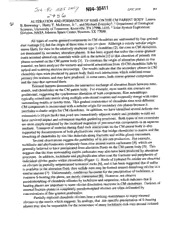
NASA Technical Reports Server (NTRS) 19940030905: Alteration and formation of rims on the CM parent body PDF
Preview NASA Technical Reports Server (NTRS) 19940030905: Alteration and formation of rims on the CM parent body
__ N94"35411 LPsc Je6 ALTERATION AND FORMATION OF RIMS ON THE CM PARENT BODY Laumn q) B. Browning l, Harry Y. McSween, Jr. !, and Michael Zolensky 2, ! Department of Geological Sciences, University of Tennessee, Knoxville, TN 37996-1410, 2 Solar System Exploration Division, NASA Johnson Space Center, Houston, TX 77058. All types of coarse-grained components in CM chondrites are surrounded by fine-grained dust coatings [1], but the origin of these rims is not yet clear. Although a strictly nebular origin seems likely for rims in the relatively unaltered type 3 chondrites [2], the rims in CM chondrites are dominated by secondary alteration phases. It has been argued that either the coarse-grained cores accreted altered rim materials while still in the nebula [1] or that alteration of primary rim phases occurred on the CM parent body [3]. To constrain the origin of alteration phases in rim material, we have analyzed the textures and mineral associations from 10 CM chondritic falls by optical and scanning electron microscopy. Our results indicate that the secondary phases in CM chondritic rims were produced by parent body fluid-rock interactions which redefined some primary rim textures and may have produced, in some cases, both coarse-grained components and the rims that surround them. Textural features demonstrate the interactive exchange of alteration fluids between rims, matrix, and chondrules on the CM parent body. For example, most matrix-rim contacts are gradational, suggesting the synchronous alteration of both components. Rim assemblages typically extend into matrix along multiple convoluted avenues and eventually merge with either surrounding matrix or nearby rims. This gradual coalescence of chondrule rims with different CM components is inconsistent with a nebular origin for secondary rim phases because it precludes a clastic origin for CM chondrites. In addition, we have identified several delicate rim extensions (<10 lam thick) that pond into immediately adjacent matrix and probably would not have survived impact and subsequent regolith gardening processes. Both types of rim extensions are most simply explained by the localized migration of precursor rim components in an aqueous medium. Transport of material during fluid-rock interactions on the CM parent body is also supported by documentation of both phyllosilicate veins that bridge chondrules to matrix and the breaching of chondrules by rim-like materials along fractures and within glassy mesostasis. Several observations suggest the possibility of in situ rim production. For example, tochilinite and phyllosilicates commonly form rims around matrix carbonates [4], which are generally believed to have precipitated from alteration fluids on the CM parent body [5]. This suggests that the rims surrounding matrix carbonates may also have been produced by alteration processes. In addition, tochilinite and phyllosilicates often coat the fractures and peripheries of individual olivine grains within chondrules (Figure 1). Rinds of hydrated Fe-oxides are observed on olivines in partially serpentinized terrestrial rocks [6], and it has been suggested that if sulfur is available in the alteration fluid, then sulfide rims may be formed around dissolving olivine in a similar manner [7]. Unfortunately, conditions favorable for the precipitation of tochilinite, a common S-beating rim phase, are poorly constrained [8]. However, we observe pseudomorphing of chondrule silicates by tochilinite and serpentine, which indicates that S- bearing phases are important to some olivine dissolution reactions in CM chondrites. Outlines of internal fracture planes in completely pseudomorphed olivines are often delineated by concentrations of fine-grained pentlandite. Partially replaced chondrule olivines bear a striking resemblance to many rimmed olivines in the matrix which suggests, by analogyl that site-specific precipitation of S-beating phases may also be responsible for the occurrence of many tochilinite-rich rims around isolated 182 LPSC XXV CM CHONDRITES: Browning, L. B., McSween, H. Y., and Zolensky, M. matrix olivines. The presence of fine-grained rims around fragmented chondrules and isolated matrix olivines is nearly ubiquitous in CM chondrites, but rarely occurs in other chondrite classes [2]. We observe isolated olivine fragments in optic continuity which are separated by rinds of tochilinite; preservation of crystallographic orientation is consistent with the preferential, in situ precipitation of tochilinite-rich rim material at the surface of the dissolving olivine. Non-silicate rims precipitate around olivines of any composition, but the process is most effective for fayalitic olivines [7]. Most of the remaining olivines in CM chondrites are relatively Mg-rich, which suggests that the precipitation of S-bearing rims on olivines may not have been an important process in the aqueous alteration of CM chondrites, despite the evidence presented above. However, compositionally-zoned olivines with forsteritic cores and fayalitic rims have been observed in CM chondrites and are common in the less-altered chondrite classes [9]. This suggests the possibility that tochilinite and Fe-rich serpentine rims observed around isolated matrix silicates in CM chondrites may reflect the preferential replacement of the outer fayalitic component of compositionally zoned olivines in CM chondrites. Although we currently have no explanation for the association of tochilinite with matrix carbonates, a nebular rim formation seems unlikely. We therefore conclude that: (1) precursor rim materials in CM chondrites were subjected to pervasive aqueous alteration on the CM parent body; and (2) textures and mineral associations observed in CM chondrites also suggest the possibility of in situ rim production. References: [IlMetzler K., Bishoff A., and Stofflcr D. (1992) Geoch#n. Cosmochbn. Acta 56, 2873-2897. [2] Rubin A. E. (1984) Geochim. Cosmochhn. Ac/a 48, 1779-1789. [3] Brcarlcy A. J. (1991) Meteoriti_'s 26,323. [4] Bunch T+E. and Chang S.(1980) Geochim. Cosmochim. Acta 44, 1543-1577. [5]Armstrong, J. T. ct al. (1982) Geochhn. Cosmo¢'hhn. A+'ta46, 575-5%. 16]Ramdohr P. (1967) N. Jh. Miner. Abh. 107, 241-265. [71Sievcr R. and W,.xxtford N. (1979) Geochim. Cosmo+'him.Acta 43, 717-724. [81Zolcnsky M.(1984) Meteoritics 19,346-347. [9] Stcclc I.M. (1986) Geochim. Cosmochim. Acta 50, 1379-1395. Figure 1: Plane light photograph of tochilinite and phyllosilicates rimming partially altered olivine in a Murchison aggregate.
